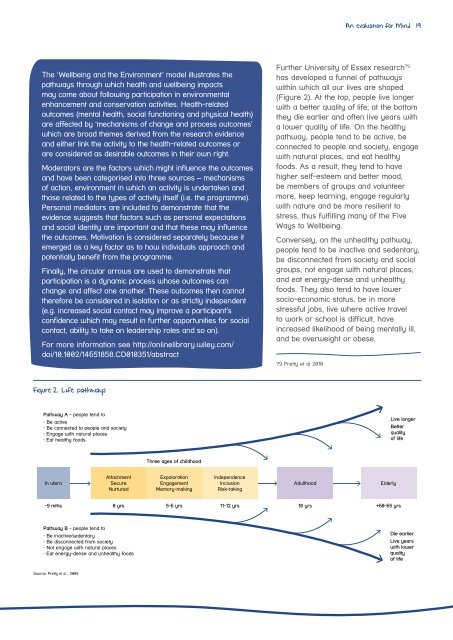Ecominds-effects-on-mental-wellbeing-evaluation-report
Ecominds-effects-on-mental-wellbeing-evaluation-report
Ecominds-effects-on-mental-wellbeing-evaluation-report
Create successful ePaper yourself
Turn your PDF publications into a flip-book with our unique Google optimized e-Paper software.
An evaluati<strong>on</strong> for Mind 19The ‘Wellbeing and the Envir<strong>on</strong>ment’ model illustrates thepathways through which health and <strong>wellbeing</strong> impactsmay come about following participati<strong>on</strong> in envir<strong>on</strong><strong>mental</strong>enhancement and c<strong>on</strong>servati<strong>on</strong> activities. Health-relatedoutcomes (<strong>mental</strong> health, social functi<strong>on</strong>ing and physical health)are affected by ‘mechanisms of change and process outcomes’which are broad themes derived from the research evidenceand either link the activity to the health-related outcomes orare c<strong>on</strong>sidered as desirable outcomes in their own right.Moderators are the factors which might influence the outcomesand have been categorised into three sources – mechanismsof acti<strong>on</strong>, envir<strong>on</strong>ment in which an activity is undertaken andthose related to the types of activity itself (i.e. the programme).Pers<strong>on</strong>al mediators are included to dem<strong>on</strong>strate that theevidence suggests that factors such as pers<strong>on</strong>al expectati<strong>on</strong>sand social identity are important and that these may influencethe outcomes. Motivati<strong>on</strong> is c<strong>on</strong>sidered separately because itemerged as a key factor as to how individuals approach andpotentially benefit from the programme.Finally, the circular arrows are used to dem<strong>on</strong>strate thatparticipati<strong>on</strong> is a dynamic process whose outcomes canchange and affect <strong>on</strong>e another. These outcomes then cannottherefore be c<strong>on</strong>sidered in isolati<strong>on</strong> or as strictly independent(e.g. increased social c<strong>on</strong>tact may improve a participant’sc<strong>on</strong>fidence which may result in further opportunities for socialc<strong>on</strong>tact, ability to take <strong>on</strong> leadership roles and so <strong>on</strong>).For more informati<strong>on</strong> see http://<strong>on</strong>linelibrary.wiley.com/doi/10.1002/14651858.CD010351/abstractFurther University of Essex research 79has developed a funnel of pathwayswithin which all our lives are shaped(Figure 2). At the top, people live l<strong>on</strong>gerwith a better quality of life; at the bottomthey die earlier and often live years witha lower quality of life. On the healthypathway, people tend to be active, bec<strong>on</strong>nected to people and society, engagewith natural places, and eat healthyfoods. As a result, they tend to havehigher self-esteem and better mood,be members of groups and volunteermore, keep learning, engage regularlywith nature and be more resilient tostress, thus fulfilling many of the FiveWays to Wellbeing.C<strong>on</strong>versely, <strong>on</strong> the unhealthy pathway,people tend to be inactive and sedentary,be disc<strong>on</strong>nected from society and socialgroups, not engage with natural places,and eat energy-dense and unhealthyfoods. They also tend to have lowersocio-ec<strong>on</strong>omic status, be in morestressful jobs, live where active travelto work or school is difficult, haveincreased likelihood of being <strong>mental</strong>ly ill,and be overweight or obese.79 Pretty et al 2010Figure 2. Life pathwaysPathway A - people tend to• Be active• Be c<strong>on</strong>nected to people and society• Engage with natural places• Eat healthy foodsLive l<strong>on</strong>gerBetterqualityof lifeThree ages of childhoodIn uteroAttachmentSecureNurturedExpolorati<strong>on</strong>EngagementMemory-makingIndependenceInclusi<strong>on</strong>Risk-takingAdulthoodElderly-9 mths0 yrs5-6 yrs11-12 yrs18 yrs+60-65 yrsPathway B - people tend to• Be inactive/sedentary• Be disc<strong>on</strong>nected from society• Not engage with natural places• Eat energy-dense and unhealthy foodsDie earlierLive yearswith lowerqualityof lifeSource:Source:PrettyPretty et et al.,al.,20092009



